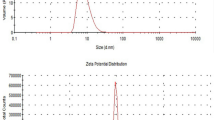Abstract
The effect of a low uptake dose of oregano essential oil with drinking water for three months (Origanum vulgare L.) on the degree of Lewis carcinoma engraftment and some parameters of oxidative stress has been studied in vivo using F1 DBA C57 Black hybrid mice. Oregano essential oil has been established to possess an anticancer activity. The degree of tumor engraftment decreased by 1.8 times, its size decreased by 1.5 times, and the development of tumor was significantly suppressed in sick mice under the effect of oregano essential oil. It was found that the uptake of essential oil did not affect the intensity of lipid peroxidation in the brain of mice and resulted in a significantly (by 36%) decreased content of secondary lipid oxidation products in the liver as shown in a reaction with thiobarbituric acid as compared to control subjects. The activity of antioxidant enzymes was found to increase after three months of essential oil uptake (by 1.5–3 times) as compared to the control group. This effect of essential oil supports the presence of bioantioxidant properties in this essential oil.
Similar content being viewed by others
References
Burlakova, E.B., in Khimicheskaya i biologicheskaya kinetika. Novye gorizonty (Chemical and Biological Kinetics: New Horizons), Burlakov, E.B. and Varfolomeev, S.D., Eds., Moscow: Nauka, 2005, vol. 2, pp. 1–27.
Bespalov, V.G., Aleksandrov, V.A., and Korman, D.B., Sib. Onkolog. Zh., 2012, vol. 50, no. 2, pp. 52–56.
Erokhin, V.N., Krementsova, A.V., Semenov, V.A., and Burlakova, E.B., Biol. Bull., 2007, no. 5, pp. 583–590.
Dragland, S., Senoo, H., Wake, K., Holte, K., and Blomhoff, R., J. Nutr., 2003, vol. 133, pp. 1286–1290.
Lampe, J.W., Am. J. Clin. Nutr., 2003, vol. 78, p. 579.
Jessup, W., Rankin, S.M., De Whalley, C.V., Hout, J.R.S., Scott, J., and Leake, D.S., Biochem. J., 1990, vol. 265, no. 2, pp. 399–405.
Oshima, S., Ojima, F., Sakamoto, H., Ishiguro, Y., and Terao, J., J. Agric. Food Chem., 1996, vol. 44, no. 10, pp. 2306–2309.
Carpenter, K.L.H., Van der Veen, C., Hird, R., Dennis, I.F., Ding, T., and Mitchinson, M.J., FEBS Lett., 1997, vol. 401, no. 1, pp. 262–266.
Meyers, K.J., Rudolf, J.L., and Mitchell, A.E., J. Agric. Food Chem., 2008, vol. 56, no. 3, pp. 830–836.
Ruberto, G. and Baratta, M., Food Chem., 2002, vol. 69, pp. 167–174.
Misharina, T.A., Terenina, M.B., and Krikunova, N.I., Appl. Biochem. Microbiol., 2009, vol. 45, no. 6, pp. 642–647.
Takahashi, Y., Inaba, N., Kuwahara, S., and Kuki, W., Biosci. Biotechnol. Biochem., 2003, vol. 67, no. 1, pp. 195–197.
Mastelic, J., Jercovic, I., Blazevic, I., Poljak-Blazi, M., Borovic, S., Ivancic-Bace, I., Smrecki, V., Zarkovic, N., Brcic-Kostic, K., Vikic-Topic, D., and Müller, N., J. Agric. Food Chem., 2008, vol. 56, no. 11, pp. 3989–3996.
Danesi, F., Elementi, S., Neki, R., Maranesi, M., D’Antuono, L.F., and Bordoni, A., J. Agric. Food Chem., 2008, vol. 56, no. 21, pp. 9911–9917.
Youdim, K.A. and Deans, S.G., British J. Nutr., 2000, vol. 83, no. 1, pp. 87–93.
Kuznetsov, A.N., Metod spinovogo zonda (Spin Probe Method), Moscow: Nauka, 1976.
Goloshchapov, A.N. and Burlakova, E.B., Biofizika, 1975, vol. 20, no. 5, pp. 816–821.
Stepovaya, E.A., Novitskii, V.V., and Ryazantseva, N.V., Bull. Exp. Biol. Med., 2003, vol. 136, no. 11, pp. 553–557.
Vartanyan, L.S., Gurevich, S.M., Kozachenko, A.I., Nagler, L.G., and Burlakova, E.B., Biochemistry (Moscow), 2001, vol. 66, no. 7, pp. 896–904.
Bukovska, A., Cikos, S., Juhas, S., Il’kova, G., Rehak, P., and Koppel, J., Mediators Inflamm., 2007, vol. 51, no. 2, pp. 254–260.
Binyukov, V.I., Borunova, S.F., and Gol’dfel’d, M.G., Biokhimiya, 1972, vol. 36, no. 6, pp. 1149–1152.
Lam, L.K.T. and Hasegawa, S., Nutrition Cancer, 1989, vol. 12, no. 1, pp. 43–47.
Author information
Authors and Affiliations
Corresponding author
Additional information
Original Russian Text © T.A. Misharina, E.B. Burlakova, L.D. Fatkullina, E.S. Alinkina, A.K. Vorob’eva, I.B. Medvedeva, V.N. Erokhin, V.A. Semenov, L.G. Nagler, A.I. Kozachenko, 2013, published in Prikladnaya Biokhimiya i Mikrobiologiya, 2013, Vol. 49, No. 4, pp. 423–428.
Rights and permissions
About this article
Cite this article
Misharina, T.A., Burlakova, E.B., Fatkullina, L.D. et al. Effect of oregano essential oil on the engraftment and development of Lewis carcinoma in F1 DBA C57 black hybrid mice. Appl Biochem Microbiol 49, 432–436 (2013). https://doi.org/10.1134/S0003683813040091
Received:
Published:
Issue Date:
DOI: https://doi.org/10.1134/S0003683813040091



